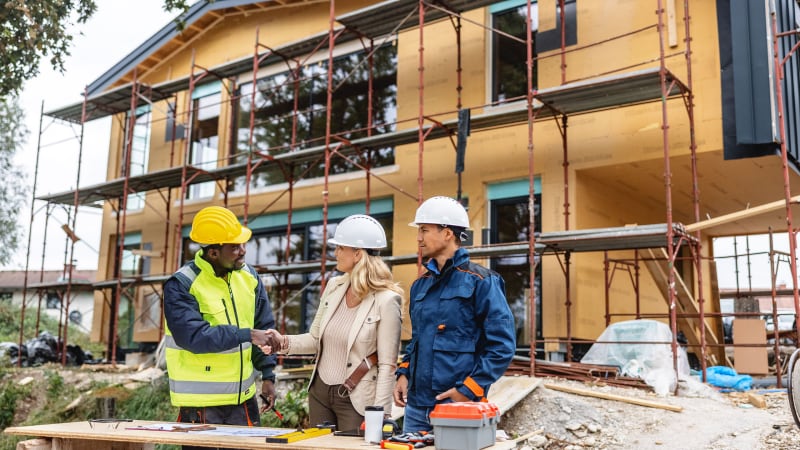Construction loan: What is it and how does it work?

This article is for educational purposes only. JPMorgan Chase Bank N.A. does not offer this type of loan. Any information described in this article may vary by lender.
When it comes to building a home from scratch or purchasing and renovating a new property, you typically won’t be looking at your traditional, permanent mortgage. That’s where a construction loan comes in. Why’s that? Construction loans are designed to help finance the construction — and sometimes renovation — of a property.
What is a construction loan?
A construction loan is typically a short-term, high-interest mortgage that helps finance construction on a property, which could include the cost of the land, contractors, building materials and permits. The interest is typically higher compared to other loans because the investment comes with a bit more risk for the lender. For example, the borrower may not have a home to use as collateral because the home hasn’t been built yet.
How a construction loan works
As opposed to one lump-sum payment with other loans, construction loans often provide financing in stages aligned with milestones in a construction timeline — typically, over a year. The same goes for interest payments. Borrowers typically make interest payments in line with the funds they've received to date, rather than interest payments based off the loan in its entirety.
With each major construction milestone, the lender will typically send an appraiser to make sure everything is up to code before moving to the next phase. Then, once the construction is complete and you’re ready to move in, you’ll need a certificate of occupancy that serves as proof that the structure is up to code in your location and that you can legally occupy the home.
You can get a certificate of occupancy at your local building or zoning inspection office. Your municipality will typically send an inspector to review the property to ensure it’s up to code. If you pass the inspection, you can finally receive your certificate, and if you don’t pass, you’ll need to make the necessary repairs before reapplying.
The money from a construction loan usually goes toward the cost of the land, contractors, building materials and permits. But what happens to the construction loan once the home is built? In some cases, you may be able to convert your construction loan into a traditional mortgage to continue paying off your new home — just as you would if you bought a property that was already built. If your construction loan can’t be converted to a permanent mortgage, then you may have to take out a new mortgage to continue paying it off. Note that some lenders may require the certificate of occupancy, mentioned above, to apply for the mortgage.
Types of construction loans
The term “construction loan” serves as a relatively high-level concept for home loans that help finance the construction, or sometimes renovation, of a home. But some construction loans are “constructed” differently than other types of loans. Keep in mind, though, that Chase doesn't currently provide construction loans.
Construction-to-permanent loan
A construction-to-permanent loan is a construction loan that turns into a traditional permanent mortgage once construction is complete. So, the loan helps cover the building timeline and then, assuming all goes to plan, turns into a mortgage with a typical monthly payment schedule. The benefit? With a construction-to-permanent loan you’re only dealing with one set of applications and closing costs.
Construction-only loan
A construction-only loan, as it sounds, covers the construction period only. So, after your construction term is up, you’ll need to either pay off the loan in full or secure new permanent financing. If you opt to secure new permanent financing, like many people often do, then additional application and closing fees may apply.
End loan
An end loan refers to a variety of mortgages that come after the construction-only loan expires, and the construction is hopefully complete. It’s the loan that comes at the “end” – get it?
Renovation loan
Renovation loans are for buyers who want to finance the repair or remodeling of a home. They can often be bundled with a standard mortgage, included as part of a refinancing plan or taken out as a personal loan, depending on your lender. For example, you may have found a home with potential in the right location, but there is a good amount you want to change about it. A renovation loan might be appropriate under similar circumstances. You might find renovation loans sponsored by both private and government lenders.
Owner-builder loan
An owner-builder loan is meant for people with construction expertise who will be both the borrower and the head of operations when it comes to building. Because an owner-builder loan is trusting the borrower to properly oversee a home’s construction, it typically requires proof of licensing, experience and overall expertise.
How to get a construction loan
If it sounds like a construction loan might be right for you, the borrower will typically give the lender a construction timeline, plans, a budget and a trusted construction leader upfront, so the financing terms are created to align with the project. Here are some steps you might take toward getting a construction loan:
- Find and hire a contractor.
- Find your desired lender and learn what you’ll need for the application.
- Consider getting prequalified, if possible.
- Devise your construction plans, budget and other necessary documents.
- Apply for your desired loan.
- Get building!
In summary
While often more complex than a standard home loan, construction loans can be helpful if you’re building a home from scratch or looking to purchase a home and make major renovations. Note that there are several types of construction loans, each matching a specific scenario. In addition, the possibility for more than one round of applications and closing costs depends on your loan structure.



